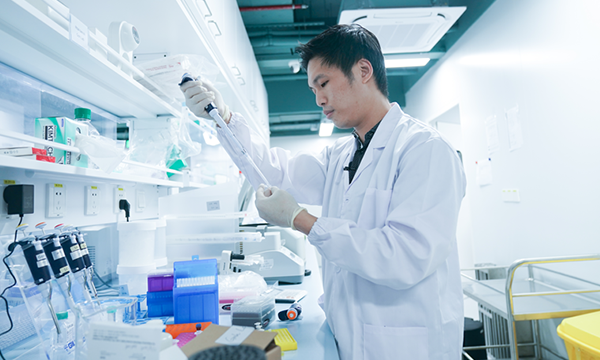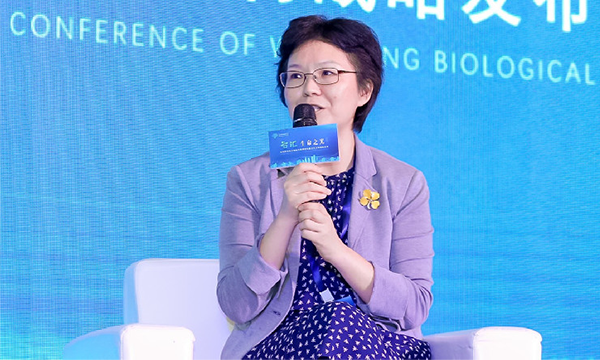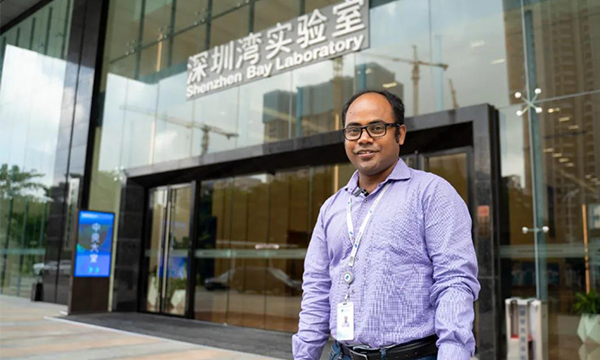After decades of development, now Shenzhen's biopharmaceutical industry has built certain advantages in industrial policy, industrial agglomeration, industrial innovation, and other aspects. The innovation of biomedicine is to find the methods of diagnosing, treating and preventing diseases in basic research on the occurrence and development mechanism of life and diseases, which include diagnostic technology, drugs and medical equipment, etc. At present, Shenzhen is in a golden development period with both opportunities and challenges. We expect Shenzhen, with its greater courage, to walk out its own path in basic research at the source, research and development of core and key technologies, and construction of scientific research institutions, explore the deep integration of clinical treatment, research and industry, and form the Shenzhen model, so as to leave a strong mark in the history of innovation and development of China’s biomedicine and contribute to human health.
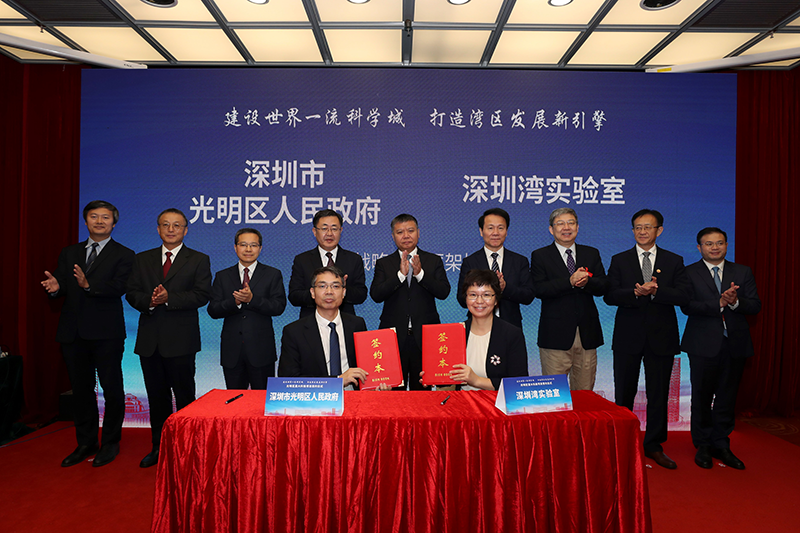
On November 14, 2019, Shenzhen Bay Laboratory and Guangming District People's Government signed a Strategic Framework Cooperation Agreement
I
I felt that our spring was approaching when Shenzhen proposed to promote the biomedical industry development.
Becoming a "very strong-minded girl" in Shenzhen Science and Technology Bureau
Life is full of unknowns and complexities, which is exactly what makes it fascinating. I have been interested in medicine since I was a child, and I hope to apply what I have learned to cure and save patients, which is a great cause in my opinion. I chose the chemistry major by accident when I enrolled for bachelor’s degree, and then I transferred to the major of Biomedical Engineering as I wished when I was studying for my master's and doctor's degrees, which made me one step closer to my ideal.
In 1996, I graduated with a doctor's degree from the University which is now known as Huazhong University of Science and Technology and came to Shenzhen with my husband. At the very beginning, I worked in a biopharmaceutical company for insulin development, but after some time, I found that the actual situation was quite different from my original research. At that time, Shenzhen just clarified the strategic idea of "taking the high-tech industry as the guide", although the development of science and technology was still weak, we could see an upward trend. Meanwhile, Shenzhen proposed to promote biomedical industry development, and I felt that our spring was coming.
So, I made a self-recommendation to the Shenzhen Science and Technology Bureau, and I was recruited smoothly since it was lack of talents in biotechnology. When I first worked there, I was mainly responsible for scientific and technological planning of biology, agriculture, new materials, and mechatronics. I deeply felt that I was shouldering the heavy responsibility for the development of the industry. With enthusiasm and courage as a newcomer, I took the initiative to contact the companies and went to do research everywhere. On the one hand, I tried to understand the development trend of the global biomedicine field; on the other hand, I was eager to know the current situation and development trend of the biological field in Shenzhen as well as the requirements of the related companies. Many people knew me as I visited a lot of companies, and they even called me a "very strong-minded girl".
Finding pain points to explore a new model of industry-university-research integration
After some research, I discovered that the biomedicine industry in Shenzhen was relatively weak as the market was full of pharmaceutical imitations while most of the pharmaceutical enterprises' products were health care products, which made it urgent to require for scientific and technological research and development. However, most enterprises lacked the ability of research and development and did not have enough funds and manpower to invest. At the same time, few scientific and technological achievements, papers and patents of universities, and research institutions could be transformed into productive forces in enterprises. The traditional scientific research system was solidified and difficult to release the power of researchers, and basic research and industrialization just fell into "two incompatible skins". Therefore, we strongly promoted the construction of new scientific research institutions.
The main body diversification initiated by new scientific research institutions, which encourages private operation with government assistance, respects the laws of research and development in the research model, and realizes the seamless connection among basic research, technology development and industrial development, promoted the combination of technology and industry, and improved the innovation efficiency. On the other hand, the R&D itself is relatively non-sensitive to the market and can go further with the support of government funds.
The Research Institute of Tsinghua University in Shenzhen is the first new research institution in Shenzhen. It combines the advantages of public institutions, universities, enterprises and scientific research institutions, innovates new ways of transforming scientific and technological achievements, and creates a new model of industry-university-research integration, that is, taking the enterprise as the main body, taking the market as the orientation, "deeply processing" high-tech achievements, and becoming the "watchman" of the market trend, the "incubator" of the enterprise, and the "blood donor" of scientific research institutions.
Since then, Shenzhen Institute of Advanced Technology of Chinese Academy of Sciences, BGI Shenzhen, Kuang-Chi Institute of Advanced Technology, and Peng Cheng Laboratory has been established one after another, which has continuously expanded the new scientific research institution teams. This type of new research institutions, which is obviously different from traditional scientific research institutions in terms of investment subjects, management mechanisms, functional positioning, and evaluation indicators, has explored a new way of deepening the institutional reform of scientific research institutions, and its outstanding performance in scientific and technological innovation and promoting the transformation of the model of economic development has aroused widespread concern in the scientific and technological circles and the economic circles.
In addition, we also helped Shenzhen enterprises establish State Key Laboratories, which achieved zero breakthroughs.
The State Key Laboratory program starting from 1984 aimed to support basic research and applied basic research. The State Key Laboratory is known as the "gold-lettered signboard" of scientific research and has always been the "patent" of universities and research institutes in the past. Later, the Ministry of Science and Technology relaxed the restrictions and opened the door to enterprises for the first time, approving enterprises to set up State Key Laboratories.
We were very happy when heard this news at that time, and hoped to take this opportunity to allow the enterprises in Shenzhen to set up key labs. After discussion, we placed our eyes on Huawei. Surprisingly, in the subsequent communication with Huawei, we found that Huawei was originally planning to establish a laboratory, but the plan had not been that mature yet. So we hit it off and applied to the Ministry of Science and Technology quickly.
In January 2008, at the Demonstration Meeting of the Feasibility of State Key Laboratory Construction Plan organized by the Ministry of Science and Technology, Huawei's plan of constructing a State Key Laboratory about "wireless communication access technology" successfully passed the demonstration, and Huawei became the only one company to set up a State Key Laboratory in the field of wireless access technology in China.
II
At the end of 2018, Shenzhen Bay Laboratory, which was constructed by the city of Shenzhen and jointly organized by the Science, Technology and Innovation Commission of Shenzhen Municipality and Peking University Shenzhen Graduate School, was established. It is also a new type of scientific research institution that we advocated in the past.
Introducing excellent talent to help Shenzhen's industrial transformation
On the road of scientific and technological innovation, excellent talent is an indispensable condition for development. As early as the 1990s, leaders of the Shenzhen Municipal Party Committee led a delegation to hold symposiums in many universities abroad to recruit talents. The method was an initiate in China at the time and aroused an enthusiastic response among international students.
With the continuous development of the economy and society, Shenzhen Municipal Party Committee and Municipal Government realized that it must innovate in policies and systems, emancipate the mind and break down institutional obstacles with greater courage, and provide the best service, the best environment and the greatest sincerity to gather elites from all walks of life.
At the time, there was strong support from Shenzhen Government for talent, and many people actively signed up. We did careful research to make sure that we picked the most suitable and the best talent and teams to perform the real work.
In the following years, we did introduce many domestic and foreign high-level talents to Shenzhen, covering the fields of electronic information, biomedicine, new materials, medical equipment, advanced manufacturing, and new energy. These talents or teams have pioneered and innovated in their own fields, injecting infinite vitality into the industry transformation and upgrade of Shenzhen.
Starting a new journey to participate in the construction of Shenzhen Bay Laboratory
After working at Shenzhen Science and Technology Bureau for nearly ten years, I started to think about my future path. In the past, I have been working in the government for overall planning and was seldom involved in the operation of specific research institutions. In 2014, it happened that Peking University Shenzhen Graduate School needed to recruit a vice president in charge of scientific research, so I immediately applied to join.
In universities, both professors and students like pursuing academic freedom. They have their own academic research interests, however, there are many problems to be solved and broken through by researchers in the actual industrial development. Therefore, I needed to strike a balance between free exploration and organized scientific research. On the one hand, I had to create a good and relaxed academic research atmosphere, and on the other hand, I pushed their research projects to meet the major needs of industries and enterprises, promoted the cooperation among professors of different disciplines, and expedited industry-university-research cooperation, so as to study the practical problems in the industry and carry out project research of a larger volume and more industrial feasibility.
At the end of 2018, Shenzhen Bay Laboratory, which was constructed by the city of Shenzhen and jointly organized by the Science, Technology and Innovation Commission of Shenzhen Municipality and Peking University Shenzhen Graduate School, was established. It is also a new type of scientific research institution that we advocated in the past. Shenzhen Bay Laboratory takes all-round and full-cycle life health protection as its mainline, focuses on the prevention and intervention of major diseases such as tumors, metabolism and cardiovascular diseases, and neurodegenerative diseases, and conducts research in biological information, biomedicine, medical engineering, and other directions, supporting the biomedicine industry and clinical medicine development in Guangdong-Hong Kong-Macao Greater Bay Area.
With my previous background in biomedicine, I was appointed as vice director responsible for preparation of the Shenzhen Bay Laboratory after its establishment. The site originally selected for the laboratory was in Nanshan, but as the Guangming Science City was completed, Shenzhen hoped to form a scientific research aggregation effect in the Guangming Science City, so we changed the site to the Guangming Science City.
Different from general companies, the laboratory has very high environmental requirements for its office building. The floor height should be at least 4 meters and the load-bearing also has special requirements, meanwhile, it needs good air circulation and special sewage treatment. It is very difficult to find a building like this. At that time, it was proposed that the construction period was three years, which was relatively short, and it was too late to build one temporarily. We searched for a long time and finally found the current building, which met our requirements in all aspects. In June 2020, the building was renovated and put into use, and the Shenzhen Bay Laboratory officially launched its operation.
III
Before a drug reaches a patient and cures a disease, it needs to go through various stages. However, I have full confidence in our team and believe that they will make new achievements with 100% of their efforts and endeavor.
Recruiting talents to make Shenzhen Bay Laboratory operate
With the establishment of Shenzhen Bay Laboratory, the first thing we need to do was to attract top talents from all over the world.
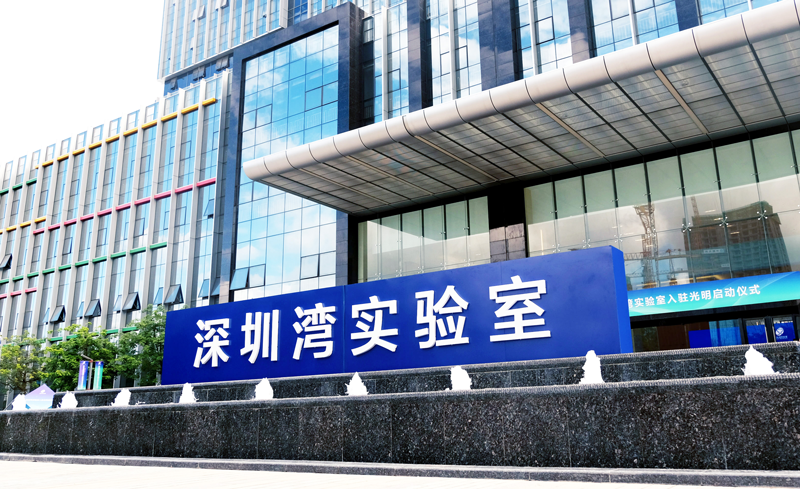
Shenzhen Bay Laboratory
On the blank paper of Shenzhen Bay Laboratory, we built a talent system with global competition which abandoned the "four-only" bias of weighing only papers, only professional titles, only academic qualifications and only awards, paid more attention to the ability and contribution of the talents, and insisted on testing talent in real practice. We believe that only in this way can we scientifically plan the systematic layout of talent introduction, optimize the talent introduction structure and strengthen the construction of a high-level innovation team.
We have introduced more than 40 full-time principal investigators, who has greatly stimulated the original innovation ability of the laboratory. People often say that Shenzhen is a young and vibrant city and we also hoped to contribute a group of young and promising scientists to Shenzhen. Many of the research fellows we have introduced are generations of the 1980s and 1990s. I often say that they are the "treasure" of our laboratory because they stood out in their own fields and promoted the development of the laboratory with innovative vitality and research results.
In addition to full-time principal investigators, we also set up the Shenzhen Bay Scholars Program to support outstanding researchers from other units to visit the laboratory for research and promote interdisciplinary integration.
It is good to have experienced research fellows, but we are not satisfied with that. Shenzhen Bay Laboratory is launching joint enrollment with Peking University Shenzhen Graduate School, the Hong Kong University of Science and Technology, Southern University of Science and Technology, and other universities, and has signed framework agreements with the College of Life Science of Zhejiang University and the Chinese University of Hong Kong (Shenzhen) to jointly build a Student Practice Base. We hope to take advantage of laboratories and universities to cultivate more innovative and interdisciplinary talent for society.
Giving play to professional knowledge and develop the COVID-19 vaccine
At the beginning of 2020, the COVID-19 epidemic broke out. As a biomedical research institute, we were keenly aware of this change and put it into action immediately.
In the initial stage, we paid close attention to the daily update on the global epidemic development and collected a large number of research materials. Since the epidemic came suddenly, almost all hospitals flocked to respond to the epidemic. We were unable to obtain the virus for experiments. So, we used computers to simulate the pseudovirus and designed antibodies and vaccines by comparing global information and data.
To this end, we also urgently set the Institute of Infectious Diseases in the system of Shenzhen Bay Laboratory, which was not planned before. The Institute of Infectious Diseases is an innovative research institute based on basic research. Combining with public health and clinical research, it aims to incubate original diagnostic plans and produce vaccines and drugs. The institute focus on and solves important scientific issues of major infectious diseases. In addition to COVID-19, we are also doing research on respiratory viruses, such as "epidemic hemorrhagic fever," which is a natural focal disease caused by Hantavirus and with rodents as the main source of infection. Through the research on these viruses, we can quickly apply and transform the latest basic research results, and provide scientific and technological support for the prevention, diagnosis, and treatment of major infectious diseases in China.
Recently, a team in the laboratory is studying the COVID-19 vaccine, which is a brand-new vaccine that has a better effect on mutated viruses. At the same time, they are also developing small-molecule drugs and plant extract medicine for the treatment of COVID-19. The current progress is subject to clinical trials. Before a drug reaches a patient and cures a disease, it needs to go through various stages such as molecular discovery, process development, expanded production, animal testing, safety evaluation, clinical trials, and listing declaration.
Counting all the links, the success rate of developing a new drug is very low, which is less than 10%. Although the road ahead is difficult and long, I have full confidence in our team that they will make new achievements through research and development with 100% of their efforts and endeavor.
IV
This city respects everyone who makes efforts and struggles for it. A small step from everyone makes a big step forward for Shenzhen.
Paying attention to Guangming Science City to promote the innovation and development of science and technology in Shenzhen
Recently, I have been elected as the Deputy of the Seventh People's Congress of Shenzhen Municipality. While concerning about the Shenzhen Bay Laboratory, I also pay attention to the development of the Guangming Science City. Over the past few months, I have carefully listened to the opinions of all parties, reviewed relavant materials, and carried out investigation and research. Focusing on the construction plan of the Guangming Science City, I put forward the question of how to make full use of the Special Zone Legislative Power of Shenzhen to formulate promotion regulations for the development of the Guangming Science City. Strengthening the construction of Guangming Science City is very important for Shenzhen to improve its original innovation ability and is also very meaningful to promote the development of scientific and technological innovation in Shenzhen.
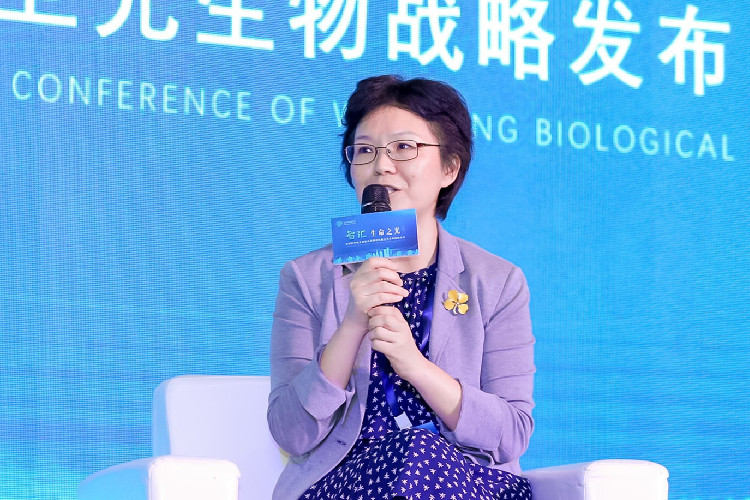
In June 2020, Tu Huan delivered a speech at the signing ceremony of the strategic cooperation agreement between Shenzhen Bay Laboratory and Weiguang Biological
Shenzhen Bay Laboratory is not an independent entity, and the surrounding facilities also affect its development, especially in terms of talent recruitment. Nowadays, scientific research teams are generally young. The key to keeping young scientific and technological talent lies in solving the education and housing problems. I hope that relevant departments can promote the high-level construction and high-quality development of Guangming Science City with strong policy conditions and a stable legal environment, and increase educational resources in Guangming district to attract more talent.
I like Shenzhen very much where I can feel warm and courageous. This city respects everyone who made efforts and struggled for it. It is a small step from everyone that makes a big step forward for Shenzhen. Shenzhen Bay Laboratory has just been established, and it is like a child who has just learned to walk. We are working hard to promote its growth and progress with innovative thinking and professional knowledge and hope that it can be built into a first-class biological information and biomedical innovation highland with major international and domestic influence as soon as possible.
With decades of development, Shenzhen's biopharmaceutical industry now has certain advantages in industrial policy, industrial agglomeration, and industrial innovation. Although Shenzhen started late in the field of biomedicine, it has created many firsts: China's first genetically engineered biopharmaceutical interferon, China's first genetically engineered hepatitis B vaccine, the world's first gene therapy drug, the first Asian genetic map, China's first medical nuclear magnetic resonance diagnostic instrument, etc. However, problems such as small industrial scale, weak collaborative development capability, low new drug research, and development level, and failure to break through the core and key technologies, still exist. In the future, the development of China's biomedicine industry will be as difficult as the exploration and breakthrough in the field of chips.
The innovation of biomedicine is to find the methods of diagnosing, treating, and preventing diseases in basic research on the occurrence and development mechanism of life and diseases, including diagnostic technology, drugs, and medical equipment. At present, Shenzhen is in a golden period of development where opportunities and challenges coexist. We look forward to seeing Shenzhen's ability to walk out its own path with greater courage in basic research at the source, research and development of core and key technologies, and construction of scientific research institutions, to explore the deep integration of clinical treatment, research and industry, and to form a Shenzhen model. In this way, we can leave a great legacy in the history of China's biomedicine innovation and development, and contribute to human health.
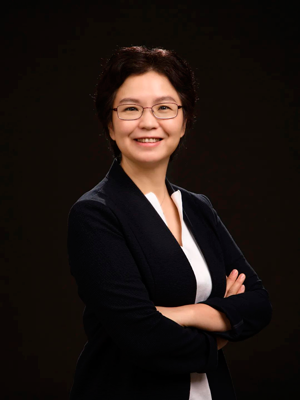
Tu Huan
Tu Huan is currently vice director of Shenzhen Bay Laboratory, vice-chairman of the Shenzhen Municipal Committee of the Democratic Progressive Party, deputy of the Seventh People's Congress of Shenzhen Municipality. She was also director of the Science and Technology Innovation Support Office of Shenzhen Science and Technology Industry, Trade and Information Technology Commission, and vice president of Peking University Shenzhen Graduate School.


